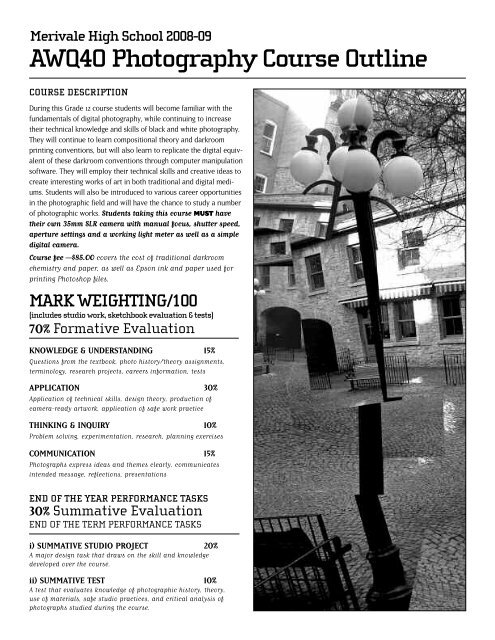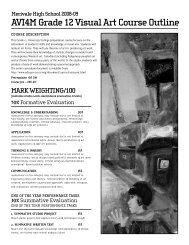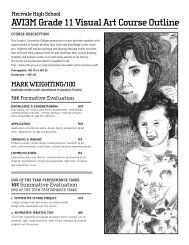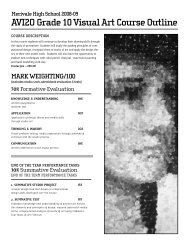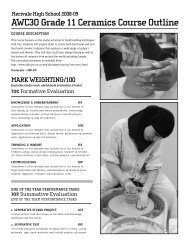AWQ4O Photography Course Outline - MHSVisualArt
AWQ4O Photography Course Outline - MHSVisualArt
AWQ4O Photography Course Outline - MHSVisualArt
Create successful ePaper yourself
Turn your PDF publications into a flip-book with our unique Google optimized e-Paper software.
Merivale High School 2008-09<strong>AWQ4O</strong> <strong>Photography</strong> <strong>Course</strong> <strong>Outline</strong>COURSE DESCRIPTIONDuring this Grade 12 course students will become familiar with thefundamentals of digital photography, while continuing to increasetheir technical knowledge and skills of black and white photography.They will continue to learn compositional theory and darkroomprinting conventions, but will also learn to replicate the digital equivalentof these darkroom conventions through computer manipulationsoftware. They will employ their technical skills and creative ideas tocreate interesting works of art in both traditional and digital mediums.Students will also be introduced to various career opportunitiesin the photographic field and will have the chance to study a numberof photographic works. Students taking this course MUST havetheir own ‹∞mm SLR camera with manual focus, shutter speed,aperture settings and a working light meter as well as a simpledigital camera.<strong>Course</strong> fee —$8∞.‚‚ covers the cost of traditional darkroomchemistry and paper, as well as Epson ink and paper used forprinting Photoshop files.MARK WEIGHTING/100(includes studio work, sketchbook evaluation & tests)‡º‚% Formative EvaluationKNOWLEDGE & UNDERSTANDING⁄∞%Questions from the textbook, photo history/theory assignments,terminology, research projects, careers information, testsAPPLICATION ‹‚%Application of technical skills, design theory, production ofcamera-ready artwork, application of safe work practiceTHINKING & INQUIRY ⁄‚%Problem solving, experimentation, research, planning exercisesCOMMUNICATION⁄∞%Photographs express ideas and themes clearly, communicatesintended message, reflections, presentationsEND OF THE YEAR PERFORMANCE TASKS‹‚% Summative EvaluationEND OF THE TERM PERFORMANCE TASKSi) SUMMATIVE STUDIO PROJECT ¤‚%A major design task that draws on the skill and knowledgedeveloped over the course.ii) SUMMATIVE TEST ⁄‚%A test that evaluates knowledge of photographic history, theory,use of materials, safe studio practices, and critical analysis ofphotographs studied during the course.
Units of StudyREVIEW of B&W PHOTOGRAPHYand COMPOSITIONAL THEORYThe Students will• recall key developments in the development of photography.• review the basic functions of a manually-operated camera.• recognize additional equipment in photography and the use(s)for each device.• identify all actions needed to properly process a roll of film.• demonstrate proper darkroom techniques and darkroom safetypractices.• survey the elements of photography.• demonstrate an awareness of additional compositional techniquesto further increase meaning within their work.ADVANCED SLR CAMERA FUNCTIONSThe Students will• develop further understanding of the Rule of Thirds and the mannerin which it reflects optical habits.• explore non-traditional viewpoints to create alternative readingsof their subject.• recognize the effects of limited depth of field through aperturecontrol in order to control planes of focus.• investigate techniques for capturing images of objects in motionwith high and low shutter speeds to create various motioncreatedblurring effects;• survey ways to capture the motion of moving light sources insituations of low light (e.g., headlights at night).• recognize alternative ways to affect contrast of static subjectsagainst the background using moving lighting devices.INTRO TO DIGITAL PHOTOGRAPHY &DIGITAL IMAGE MANIPULATIONThe Students will• survey the development of digital imaging from early experimentsto today’s technology with a focus on key points of its evolution;• Identify key differences between film and digital cameras;• differentiate between different camera types in the digital imagingcategory;• recognize alternative forms of creating digital images other thanthrough camera photography (i.e., scanning);• distinguish between different colour modes and file types indigital imaging;• recognize the different requirements for digital images based onintended use (i.e., Internet vs process printing); and• compare different software titles for digital image processing basedon price and versatility.THE DIGITAL DARKROOMThe Students will• be familiar digital imaging software equivalents for improvingthe complete image.• identify digital imaging software equivalents for improvingcomponents of the image rather than the whole.• survey techniques for manipulating colour within an image.• explore processes for replicating advanced presentation techniquesof traditional prints into digital form such as feathering,vignetting, and sepia tones.• demonstrate the ability to repair tears, scratches and discolourationof negative and print images using digital imaging software.COMBINING TRADITIONAL & DIGITALFOR CREATIVE SOLUTIONSThe Students will• be familiar with techniques for altering existing photographsusing digital imaging software (e.g., adding or removing elements).• explore manipulations of digital images using creative filters andother image-altering options within the digital imaging software.• demonstrate the ability to create images by combinging elementsfrom other images using layers.• survey alternative uses for digital images with a variety ofcommercial products available such as labels, iron-on transfers, etc.PHOTOGRAPHIC CAREERSThe Students will• demonstrate the ability to analyse images by others critically.• identify potential careers related to photography.• explore photography-related post-secondary options.• recognize the requirements for different situations professionalphotographers face on a regular basis such as wedding portraitsand baby pictures.• understand the nature of the relationship with the client incommercial photography.• be cognizant of copyright issues relating to photography.
STUDENT EXPECTATIONS• Come to class daily with afunctioning 35mm camera anddarkroom materials, as well asbinder and writing implement.• Maintain good work habits inboth the classroom & darkroom.• Submit work that is originaland represents your own effort.(see Academic Honesty/Artistic Integrity)• To seek clarification from yourteacher if assignment criteria,theory or marking rubric is notfully understood.• To take part in <strong>Photography</strong>field trips• To participate in MerivaleHigh School’s Annual StudentArt Showcase• To hand in all projects andassignments on or before theassigned due date.LATE ASSIGNMENTS ANDCONSEQUENCESStudents will be allowed a window to hand in work withoutpenalty up to two days for minor assignments, and up to fourdays for major projects. You must present an acceptable reasonfor the late assignment on the missed due date if a zero is to beavoided and a contract for an alternative assignment/due datemay be drawn up. Where possible, present reasons to theteacher prior to the due date.After this period, unless there are extenuating circumstances(accepted at the teacher’s discretion), late assignments mayreceive a reduced mark, a “no mark” or a mark of “zero” basedon the contract (if used) and situation, and the expectations tiedto the assignment.If the student fails to complete the assignment as specified inthe completion contract, a placeholder mark of “NM”, “OMIT”,“_____” (blank) or “INC” (incomplete) will indicate the lack ofevidence. These placeholders will excuse the mark until the endof the reporting period. If the teacher has no evidence of thestudent’s knowledge or skills related to the expectations evaluated,a zero will represent the student’s absence of evidence ofthat learning.Each semester will have a final due date to evaluate all outstandingwork. It will be posted in the Art Department well in advance.GROUP WORK AND ORALPRESENTATIONSPlease note that these are time and/or team sensitive. A “zero”may be recorded if you do not participate at the specified times.If there are extenuating circumstances (subject to teacher’sdiscretion), alternate arrangements may be made.MISSED TESTSIf a test is missed while you are absent for an acceptable reason,you must be prepared to write the missed test on the day youreturn to school. Consult with your teacher before the test ismissed (if possible) or as soon as possible in other circumstances.
ACADEMIC HONESTY / ARTISTIC INTEGRITYIf you’re going to lick the icing off somebody else’s cake, youwon’t be nourished and it won’t do you any good, — or youmight find the cake had caraway seeds, and you hate them.(Emily Carr)THESE BEHAVIOURS CONSTITUTE ACADEMIC DISHONESTY:PLAGIARISMSELF-PLAGIARISMFABRICATIONDECEPTION, ANDCHEATINGIt is the responsibility of every visual art student to ensurethat all assignments which are to be evaluated are original,personal works and are accurately documented as outlined bythe teacher. With this in mind, most of the studio work shouldbe done at school.If more time is needed than is given during class, art roomscan be opened during lunch and/or after school – be sure thatarrangements are made with your teacher.DISHONEST ARTISTIC ACTIVITY INCLUDES — the submissionof someone else’s art work (in whole or in part) as your own;giving work to someone else to be copied and submitted;directly copying an existing work and claiming it is yourown original creation.In today’s digital environment, the temptation to compromiseartistic integrity is greater than ever. There is a fine linebetween being inspired by great art and the creation newthreads of expression. If you are unsure of your direction withany visual art project, consult with your teacher.CONSEQUENCES FOR ACADEMIC DISHONESTY:1. The teacher will inform parents/guardians that the studenthas submitted work which is not original.2. If a student uses dishonest or fraudulent means in completingany assignment, a mark of zero will be assigned to thatpiece of work.3. The incident will be documented with the school principaland kept on record for one academic year.4. Student will not be considered for academic awards and/orincluded in the Honour Roll if applicable in the year in whichthe academic dishonesty occurs.5. Merivale High School will not nominate or sign applicationsfor scholarships or awards for students who are confirmed ascommitting academic dishonesty in the year the academicdishonesty occurs.6. The student will be required to complete an AcademicHonesty seminar. These seminars are held two times eachsemester outside the school day.7. Senior students may be allowed to submit a proposal whichdefines an alternate assignment they believe will allow themto demonstrate achievement of the curriculum expectations.YOUR SIGNATURE BELOW ACKNOWLEDGES THAT YOU HAVE READ THIS DOCUMENT_________________________________________Student name__________________________________________Parent/Guardian name_________________________________________________Student Signature____________________________________________________Parent/Guardian SignatureDate _____________________, 2009


